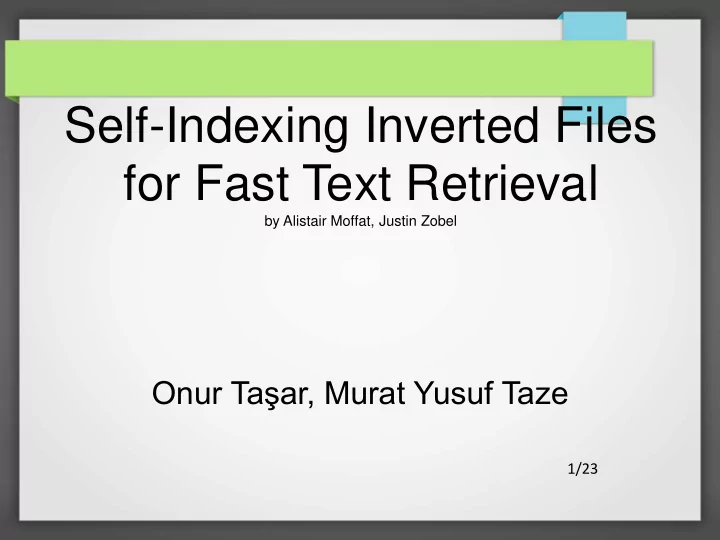

Self-Indexing Inverted Files for Fast Text Retrieval by Alistair Moffat, Justin Zobel Onur Taşar, Murat Yusuf Taze 1/23
Overview ● Background Information ● Query Processing – Boolean and Ranking ● Compression ● Motivation ● Fast Inverted Index ● Skipping ● Implementation, Experimental Results ● Conclusion 2/23
Indexes ● Indexes are data structures designed to make search faster ● Text search has unique requirements, which leads to unique data structures ● Most common data structure is inverted index – general name for a class of structures – “inverted” because documents are associated with words, rather than words with documents 3/23
Inverted Index ● Each index term is associated with an inverted list – Contains lists of documents, or lists of word occurrences in documents, and other information – Each entry is called a posting – The part of the posting that refers to a specific document or location is called a pointer – Each document in the collection is given a unique number – Lists are usually document-ordered (sorted by document number) 4/23
Example “Collection” 5/23
Example “ Inverted Index ” Simple Inverted Index 6/23
Example “ Inverted Index ” Inverted Index with counts • supports better ranking algorithms 7/23
Example “ Inverted Index ” Inverted Index with positions • supports proximity matches 8/23
Information Retrieval ● Two main mechanisms for retrieving documents – Boolean Queries ● a set of query terms connected by the logical operators AND, OR, and NOT – Range Queries ● matching an informal query to the documents ● allocating scores to documents according to their degree of similarity to the query 9/23
Query Processing ● inverted lists are read from disk ● the lists are merged, ● taking the intersection of the sets of document numbers for AND operations, the union for OR, and the complement for NOT 10/23
Example ● their conjunction are documents 13 and 60 – Terms are connected by AND operator. 11/23
Ranking vs Boolean ● More memory is required because in a ranked query there are usually many candidates – In a conjunctive Boolean query the answers lie in the intersection of the inverted lists, but in a ranked query, they lie in the union – In a conjunctive Boolean query, the number of candidates need never be greater than the frequency of the least common query term ● More time is required because conjunctive Boolean queries typically have a small number of terms, perhaps 3 – 10, whereas ranked queries usually have far more 12/23
Compression ● for space efficiency, the inverted lists are stored compressed – For example, the list – 5, 8, 12, 13, 15, 18, 23, 28, 29, 40, 60 – corresponding d-gaps: – 5, 3, 4, 1, 2, 3, 5, 5, 1, 11, 20 (good for variable-length encoding ) ● Without compression, an inverted file can easily be as large or larger than the text it indexes 13/23
Compression ● Advantage – net space reduction of as much as 80% of the inverted file size ● Disadvantage – even with fast decompression it involves a substantial overhead on processing time 14/23
Motivation ● Problem: How to reduce these space and time costs if we compress indexes. ● Solution: A mechanism called Self-Indexing ● For typical conjunctive Boolean queries processing time is reduced by a factor of about five. ● the overhead in terms of storage space is small, typically under 25% of the inverted file, or less than 5% of the complete stored retrieval system 15/23
FAST INVERTED FILE PROCESSING Skipping Consider the set of ● <5, 1><8, 1><12, 2><13, 3><15, 1><18, 1>... ● Stored as d-gaps: ● <5, 1><3, 1><4, 2><1, 3><2, 1><3, 1>... 16/23
Skipping continued Synchronization points Skip over every three pointers: ● <<5, a2>><5, 1><3, 1><4, 2><<13,a3>><1,3> <2,1> <3,1>... ● Still redundancy, code differently: ● <<5, a2>><1><3, 1><4, 2><<8, a3-a2>><3> <2,1><3,1>... ● Find the correct block 17/23
Implementation Storage Let L be the value of k Size of skipped inverted files for a dataset becomes: 18/23
Implementation Performance on Boolean Queries 19/23
Implementation Ranked Queries ● Any document containing any of the terms is considered as a candidate. ● We need to restrict the number of accumulators ● Two algorithms: ● Quit ● Continue 20/23
Experimental Result Top 200 documents are returned 21/23
Conclusions Advantages: ● CPU time is reduced ● Only compressing the pointers save the space but increase the processing time ● The idea can be applied to both the boolean queries and the ranked queries 22/23
References Addison Wesley, 2008 • G. Salton. Automatic Text Processing: The • Transformation, Analysis, and Retrieval of Information by Computer. Addison-Wesley, Reading, Massachusetts, 1989. G. Salton and M.J. McGill. Introduction to Modern • Information Retrieval. McGraw-Hill, New York, 1983. 23/23
Recommend
More recommend